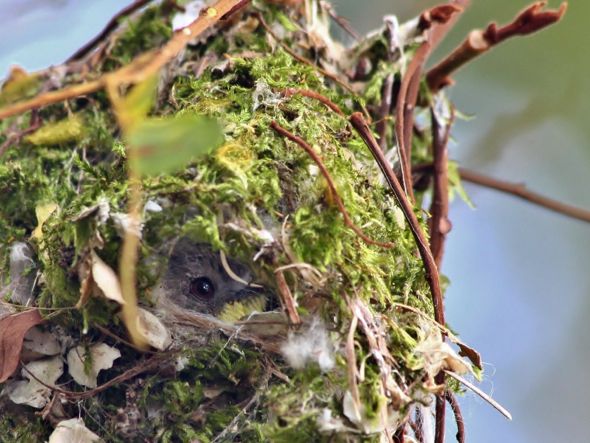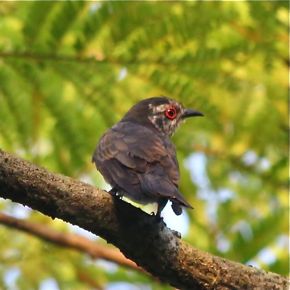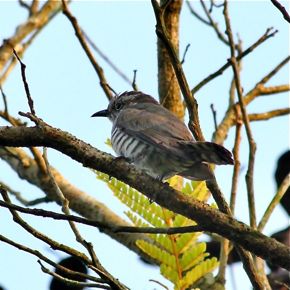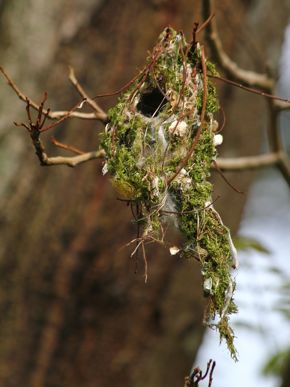“The Golden-bellied Gerygone (Gerygone sulphurea) (above) has been previously documented hosting chicks of the Little Bronze Cuckoo (Chrysococcyx minutillus), which is its known brood parasite. In two previous cases known to me, the gerygone nests were both taken over by cuckoo chicks. Hence, when another active nesting of the Golden-Bellied Gerygone was discovered in mid May 2012, I was naturally eager to find out whether this time round, the gerygone would be successful in brooding its own species instead of cuckoos.
“On my first visit, the nest was already fully completed. However, the gerygone (not sure whether one or both birds) was still fetching nesting material to line the interior of the nest. The nest was exposed in the open but its entrance was well camouflaged and was visible only from certain angles (above left). A cleverly designed porch, which was inclined steeply, was attached at the top of the entrance. It was partially covering the entrance and thus shielding its interior from prying eyes. One of the gerygones was observed entering the nest where it remained (above right). The bird could be seen peeping out from its nest occasionally as its eye was visible (below). The bird in the nest was, presumably, the female. It was possibly laying eggs or incubating. The male was nearby as its sharp shrill calls could be heard from the canopy above. It was keeping an eye for intruders and standing guard for its mate. It defended its turf fearlessly – even chasing away a species that was more than twice its size! Surprisingly, the Black-naped Oriole (Oriolus chinensis), which is known to be aggressive and raider of nests, retreated without a fight.
“One week later, the gerygones were still actively nesting. As before, one was in the nest and the other performing guard duty. I decided to leave after observing that there was not much activity. As I was leaving, a pair of Little Bronze Cuckoos was spotted a little distance away (below: male left, female right). An uneasy feeling crept to me as this seemed not to bode well for this nesting. The cuckoos were probably not more than fifty metres away from the gerygone nest. Were they aware of the gerygone nesting and waiting for an opportune time to make their move?
“After another week, on 3 June 2012, I was taken aback when I caught sight of the nest. It was worse than what I had feared. The nest was still intact, but its porch, which had camouflaged its entrance so well, was missing. The entrance seemed to be enlarged and the nest proper was now fully exposed to the elements (left). Could it be the work of the Little Bronze Cuckoo? Or have the nest been raided by the Black-naped Oriole, or perhaps another bird, a snake, or even a squirrel?
“Sadly, the gerygones were gone; confirming the failed nesting.”
.
Kwong Wai Chong
Singapore
6th August 2012
















3 Responses
Is there no way to keep spammers away?
For ever 100 or more, one slips through.
What we can do is, and that’s what I usually do, for the one that slips through, to alert our admin.